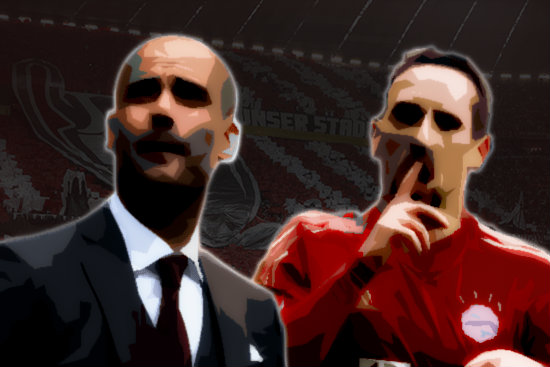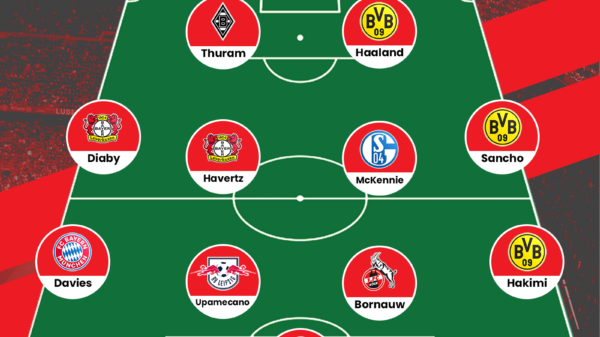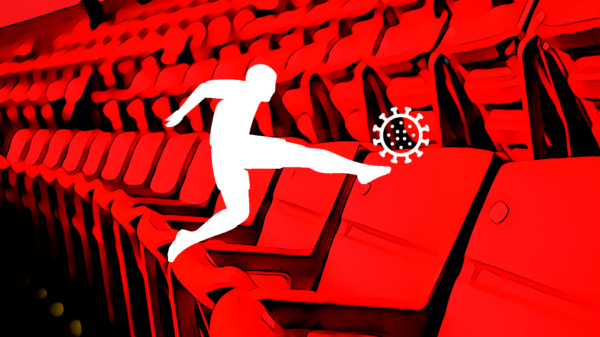The abundance of football talent that’s on display for the entire world to see week-in week-out is unreal. What’s even more intriguing is the fact that so many players sustain the same level of performance over the span of the entire season. The quality of players in a club in a given season predominantly defines its chances of winning silverware in that season. However, in my opinion, success isn’t measured merely by the number of trophies a club has in its cabinet. There are other facets – such as a good reputation, loyal fans, consistent performances, etc., which can be built only in the long run. Therefore, a club that produces generations of quality players that consistently win trophies, creating history at every possible turn, is a lot more respectable and likable than clubs that achieve success overnight.
Thus on comparing two clubs such as Bayern Munich and Manchester City, who are both giants in Europe at the moment, there are many glaring differences with respect to how they achieved this status and how they operate. What Bayern (as a club) are today, is a result of decades of hard work, consistency, democratic ownership and secure financial conditions, among other factors. These factors cannot be achieved overnight by clubs such as Manchester City, who only recently became a ‘top’ side, with heavy investment by their owners, the Abu Dhabi United Group in 2008. Even then, their first trophy under the new regime came only 3 years later, in 2011, when they won the FA Cup. I’m not singling out Manchester City, mind you. The same can be said about other clubs with foreign owners too, such as Chelsea, PSG and AS Monaco.
Alright, let’s back up a little. I mentioned above, the presence of quality players in a club is vital to achieving success. They’re one of the main components of a title winning campaign; however, they’re not the only components. Quality players having little or no team chemistry, lack of familiarity with the manager’s desired tactics or indifference thereto can render any hope of success…futile – as was the case with Andre Vilas-Boas’ Spurs. Arguments will never cease, but truth is Bayern, Madrid and Barcelona would make a lot of people’s top 3 teams in terms of talented players (combined with above-mentioned components).
Bayern in particular, has truckloads of talent at its disposal. The only real concern is in their central defense, which I expect to be strengthened in the summer. Their midfield for me is the best in the world. You may argue that Barcelona’s midfield quartet is superior, but when you compare the depth in their squads for each of these positions, Barcelona are clearly lacking (in current ability, not potential ability). Bayern, however, have two or more players backing up for each of their midfield positions.
There have been a lot of inward transfers at Bayern since the 2012 summer transfer window, during which they added Javi Martinez and Xherdan Shaqiri to their already powerful list of midfielders consisting of Schweinsteiger, Kroos, Gustavo, Muller, Ribery, Robben, and Tymoschuk. They bolstered their defense by signing Brazilian centre back Dante and brought in Mario Mandzukic to cover for the injured Mario Gomez. It looked like they wouldn’t need to purchase anyone for the next few transfer windows. However, the season following the treble (2012/13), they managed to surprise us all again by signing two world class talents in Mario Gotze from Dortmund and Thiago from Barcelona. As is apparent from these signings, Bayern seem to have taken over from Barcelona as the new breeding ground for some of Europe’s most talented players.
Here are some of the reasons why players would prefer a move to the Bavarians (or the Bundesliga in general) over other clubs in other top leagues.
1. History and Successes
The most obvious reason for any player to join any club is its history. Bayern are the most successful German club in the world and the third most successful club ever, behind Barcelona and Real Madrid (in terms of silverware). Their cabinet includes a wide range of trophies including 50 domestic titles and 8 European titles.
They have also had some of the most notable players in the world – (legends as we call them) – play for them at some point. Some of these include Franz Beckenbauer, Gerd Muller, Sepp Maier, Uli Hoeness, Lothar Matthaus, Rummenigge, Paul Breitner and Oliver Kahn.
A club’s fans are the club’s lifeblood. In the absence of fans, a club can merely exist physically as an organization rather than, say, a family. When an individual goes through a nervous breakdown, he can count on his family to hold him together – and when he’s happy or has achieved something, he has his family to share this triumph with. Similarly, the club needs its fans (family) the most when it’s going through a rough patch, but it also shares its successes with them.
The impact Bayern’s fans have had on them cannot be overstated. They rank among the most loyal and passionate set of football fans in the world, serving the team as a catalyst to perform better on countless occasions and supporting them through good times as well as the not so good ones, just like a family does.
2. Brand Value
Various factors are taken into account before calculating a club’s brand value. According to Brand Finance, a football club’s brand value is essentially the sum total of these factors:
- Fixed Tangible Assets (stadium, training grounds, etc)
- Intangible Assets (purchased players) having their own brand value (includes their market value)
- Internally developed players
- Revenues from various sources
- Goodwill
Bayern Munich has consistently been amongst the most valuable brands in football. Brand value can be an important factor influencing a player to join a club since players feel an affinity towards teams that are highly valued (similar to a guy attracted to one of the prettiest girls in college). The value of the club is intangible to a player considering his options, but is portrayed in the form of tangible media such as number of trophies, quality of players in the current squad, iconic past players, etc.
According to Brand Finance, a popular branding agency, in 2012, Bayern ($786 million) overtook Real Madrid and Chelsea to bag 2nd place in the list of the most valuable brands in football, next only to Manchester United ($853 million). They saw a whopping 59% increase in their value as compared to 2011.
The following year, they successfully managed to dislodge the Reds to become the most valuable football brand in the world. Bayern’s brand as of May 2013 was worth $860 million. This was primarily due to the Champions League final victory over arch rivals Dortmund, which gave them access to a wider global audience.
3. German model of football
The general structure of football in the Bundesliga is something that leaves me in awe every time I read about it. It’s arguably the best sporting model in the whole of Europe, something that other prominent leagues should take note of. This is probably one of the latent factors that enable a player to choose between a team in the Bundesliga and one in the other top leagues. This German football model envisages two key features.
– Low Ticket Prices: Strange though it may seem, ticket prices could ultimately have a say in the player’s decision to move to a club. Ticket prices in the Bundesliga are ridiculously cheap. And when you compare them with those of the Spanish or the English leagues, you’ll be shocked. The stable financial conditions with most Bundesliga clubs is in stark contrast to those in the other leagues, where many clubs are neck-deep in debt, and hence feel the need to increase their revenue by way of high ticket prices. On the contrary, not only are most German clubs free of debt, there’s a good chance that they’re making profits too, thus reducing the pressure to recover money through gate receipts.
Lower ticket prices are beneficial to the fans, primarily – as they can afford to watch their team, live at the stadium. There are thousands of football fans in the world who are unable to watch their team play every week due to the high prices.
Secondarily, they also help the club build its reputation and goodwill – and thus, its brand value. The cheaper the tickets, the greater the average attendance at the stadium.
It may also result in a drastic fall in the seat allocations for the wealthy corporates. These seats, which would otherwise be occupied by high-end businessmen from the corporate sector (dressed in suits and for all you know, discussing business during the match), will now contain fans that are actually passionate about football and whose teams’ success/failure would impact them on a purely emotional level. The fans serve as an extra man for their team at times and can replenish the team with much needed confidence and belief when in a losing position. For example, Liverpool fans at Istanbul singing You’ll Never Walk Alone during half time when the their team was 3 goals down against AC Milan, stirred something within the players, resulting in one of the best cup finals ever played. The fans of a club are key contributors to its success and its brand value – which in turn attracts quality players.
– Ownership: Barring a couple, all teams in the Bundesliga are owned by members who hold stakes in the club. In Germany, there is a rule (50 + 1), whereby the club must have a controlling stake of 51% or greater, so that commercial interests do not interfere in the club’s internal affairs. The best example would be Bayern Munich, where members own 82% of the club. The remaining 18 % are split equally between Adidas and Audi. The significance of this is that the owners of the club (the members) are not sidetracked into worrying about anything other than guiding the club to its potential. There is no profit motive in such a club.
In contrast, an owner being an individual and a billionaire is always distracted by the need to recover all the money invested in the club. When they are motivated primarily by profits, their tolerance towards poor performances is always diminishing. And when they can’t stand it anymore, the manager gets sacked. The entire process goes on and on, thus leaving no room for stability in these clubs. Every player needs some amount of managerial stability in order to develop to his full potential. Different managers coming in every season and imposing an assortment of playing styles upon the players, more often than not stunts their growth. This is especially true in case of players with exceptional talent who have high ambitions – when their growth is hindered over a relatively long period due to the club’s poor organizational structure, they run the risk of never being able to realize their goals.
4. Young and talented manager, hungry for success
Pep Guardiola signing a three year deal with Bayern Munich after being heavily linked to Chelsea was surprising news, to be honest. The former Spain midfielder, in his four years as manager of Barcelona, won 14 trophies.
His preferred style as a manager is to retain possession of the ball at all costs. He likes his team to play slick one-two passes and then exploit any potential gap in the opposition defense. He advocates a disciplined, aggressive, high pressing game in order to recover possession so they can repeat the same process over and over. It’s a simple philosophy, and it’s brought him great success.
The modern footballer is often characterized by his ability to pass, dribble, play through balls, his flawless physique, solidity in defense, etc. Hence, it can logically be inferred that the modern footballer would love to play for a manager like Guardiola, who shows great faith in youth. He’s easily one of the best managers in the world at present, and arguably the world’s best young manager.
5. Superior Infrastructure
Sound infrastructure is one of the most fundamental requirements of a professional football club, and as you’d expect, Bayern Munich definitely do not fall short in this regard. Their stadium, training and youth facilities are simply exquisite.
The Allianz Arena is the home of the Bavarian outfit. It’s most widely known for the diamond shaped panels on the outside forming the world’s largest membrane cladding. It’s the first and only stadium in the world which is capable of fully changing colors on the exterior. During home games at the Allianz, the exterior is lit in red, giving the entire stadium a really classy look. The initial capacity when the Stadium was constructed in 2005/06 was around 66000. Eight years on, the seating capacity is almost at 70000. It is extremely fan-friendly, with hundreds of car parks, seats to match the needs of a large range of supporters (from rich businessmen to fans part of the standing crowd). Visiting the Allianz Arena is a distant dream for millions across the globe.
Bayern’s training ground is known as the Sabener Strasse. This facility offers top class training and playing conditions for the players. There are 5 pitches of which 2 of them even possess under soil heating. These turfs are tended to daily by the groundsmen. This 80,000 metre site also features two artificial turf pitches, a beach volleyball court and a multipurpose sports hall. Every single individual ranging from the kids to the senior-most professionals is greatly benefited from these facilities.
The Sabener Strasse youth academy has seen many great players graduate from it. Top professionals like Owen Hargreaves, Bastian Schweinsteiger, David Alaba and Holger Badstuber were a part of this academy a few years ago. The academy includes a residential building which accommodates upto 14 players between the ages 15 and 18, who live too far away from Munich to commute daily to training. Talented young footballers seeking to follow the footsteps of players such as Alaba, Schweinsteiger, etc. are assured of the careful nurturing and development of their skills at the academy which lays down the perfect foundation for a young player’s career in football.
In addition to the reasons highlighted above, it is to be duly noted that the Bundesliga is now the 2nd most popular league in the world and is slowly (but not so surely) catching up with the English Premier League. Moves to the Bundesliga in recent times are generally seen as highly beneficial to the player as Germany is one of the best places for youth development.
The article was written by @Arjooon
Sources: brandfinance.com for the brand values; fcbayern.de for information on the club’s infrastructure.
- Indian Super League: Progress for Indian Football? - February 4, 2015
- Luis Suarez | Once Bitten, Twice Shy? Nah! - June 30, 2014
- Liverpool- Transfer Window of Lost Opportunity? - February 3, 2014



























































